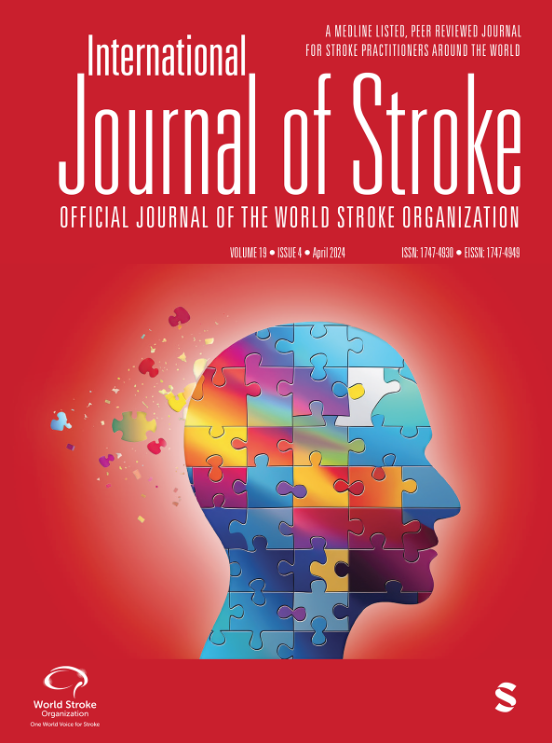与脑卒中后认知障碍相关的战略性白质高密度位置:一项针对 1568 名脑卒中患者的多中心研究
IF 6.3
2区 医学
Q1 CLINICAL NEUROLOGY
引用次数: 0
摘要
背景中风后认知障碍(PSCI)发生率高达 50%。目的我们研究了战略性白质束中的 WMH 是否能解释中风后的认知表现。方法通过 Meta VCI 地图联盟统一了来自 9 个缺血性中风队列的 MRI 患者个体数据。我们使用线性混合模型和套索回归评估了战略束中 WMH 体积与特定领域认知功能(注意力和执行功能、信息处理速度、语言和言语记忆)之间的关联。我们采用了假设驱动设计,主要针对已知对记忆门诊患者具有战略意义的四条白质束:丘脑左右前辐射、大镊子和左下前枕束。WMH总体积与所有四个认知领域的认知表现密切相关。左丘脑前部放射区的WMH体积与注意力、执行功能和信息处理速度的认知表现显著相关,而镊子大部的WMH体积与信息处理速度显著相关。多变量套索回归显示,这些关联与年龄、性别、教育程度和梗死总体积无关,且系数大于 WMH 总体积。这意味着 PSCI 中战略病变的概念超出了急性脑梗塞的范围,还涉及到预先存在的 WMH。数据可用性Meta VCI 地图联盟致力于数据共享,并遵循我们的指导方针。本文章由计算机程序翻译,如有差异,请以英文原文为准。
Strategic white matter hyperintensity locations associated with post-stroke cognitive impairment: a multicenter study in 1568 stroke patients
BACKGROUNDPost-stroke cognitive impairment (PSCI) occurs in up to 50% of stroke survivors. Presence of pre-existing vascular brain injury, in particular the extent of white matter hyperintensities (WMH), is associated with worse cognitive outcome after stroke, but the role of WMH location in this association is unclear.AIMWe determined if WMH in strategic white matter tracts explain cognitive performance after stroke.METHODSIndividual patient data from 9 ischemic stroke cohorts with MRI were harmonized through the Meta VCI Map consortium. The association between WMH volumes in strategic tracts and domain-specific cognitive functioning (attention and executive functioning, information processing speed, language and verbal memory) was assessed using linear mixed models and lasso regression. We used a hypothesis-driven design, primarily addressing four white matter tracts known to be strategic in memory clinic patients: the left and right anterior thalamic radiation, forceps major and left inferior fronto-occipital fasciculus.RESULTSThe total study sample consisted of 1568 patients (39.9% female, mean age: 67.3 years). Total WMH volume was strongly related to cognitive performance on all four cognitive domains. WMH volume in the left anterior thalamic radiation was significantly associated with cognitive performance on attention and executive functioning and information processing speed, and WMH volume in the forceps major with information processing speed. The multivariable lasso regression showed that these associations were independent of age, sex, education, and total infarct volume and had larger coefficients than total WMH volume.CONCLUSIONSThese results show tract-specific relations between WMH volume and cognitive performance after ischemic stroke, independent of total WMH volume. This implies that the concept of strategic lesions in PSCI extends beyond acute infarcts and also involves pre-existing WMH.DATA AVAILABILITYThe Meta VCI Map consortium is dedicated to data sharing, following our guidelines.
求助全文
通过发布文献求助,成功后即可免费获取论文全文。
去求助
来源期刊

International Journal of Stroke
医学-外周血管病
CiteScore
13.90
自引率
6.00%
发文量
132
审稿时长
6-12 weeks
期刊介绍:
The International Journal of Stroke is a welcome addition to the international stroke journal landscape in that it concentrates on the clinical aspects of stroke with basic science contributions in areas of clinical interest. Reviews of current topics are broadly based to encompass not only recent advances of global interest but also those which may be more important in certain regions and the journal regularly features items of news interest from all parts of the world. To facilitate the international nature of the journal, our Associate Editors from Europe, Asia, North America and South America coordinate segments of the journal.
 求助内容:
求助内容: 应助结果提醒方式:
应助结果提醒方式:


